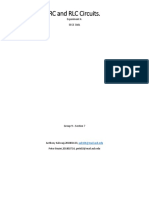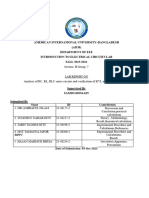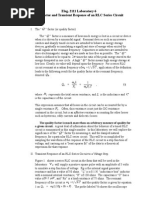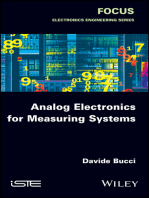Lab 10
Uploaded by
aznia shireenLab 10
Uploaded by
aznia shireenEEE121 - Electric Circuits Analysis I
LAB ASSESSMENT
In- Post Lab Total
Lab
Data Data Writing Style
Presentation Analysis
Lab 10: To analyze the sinusoidal response of
RLC Circuit out of course
Pre Lab
Calculation of Square Wave response of RLC Circuit
I. Assemble the circuit shown in Figure 2 on the breadboard.With
values R= 220Ω, C= 3.3uH, L= 5mH and f = 20 kHz, observe
the waveform when the output is taken across the resistor.
You will use the function generator to provide a square wave
a.c voltage of 6V peak to peak, and the oscilloscope to
measure the output. Figure 1
II. Sketch the waveform you observed on the oscilloscope on the
graph given.
III. Simulate your circuit in Ltpice, select New Simulation and select Bias Point (Transient) Analysis
in the simulation menu. Run to simulation to a 100ms. To provide a square wave at the input use the
VPULSEpart from the part menu. Set the values as shown in figure 12.5. Save your simulation on the
desktop.
τ and T1/2
The product of the resistance and capacitance, RC, governs the time scale with which Figure 2 the
changes take place. For this reason, it is called the time constant, which we call τ (tau). It can be found indirectly by
measuring the time required for the voltage to fall to Vo/2 (see Figure below). This time interval is called the half-life,
T1/2 , and is given by the equation T1/2 = (ln2)τ, soτ = T1/2 /ln2 = T1/2 /(0.693).
TECHNIQUE FOR FINDING HALF-LIFE
Here is a method for finding T1/2.
Change oscilloscope gain (volts/cm) and sweep rate (ms/cm) until you have a
large pattern on the screen. Make sure the sweep speed is in the “calibrated”
position so the time can be read off the x-axis.
Center the pattern on the screen so that the horizontal axis is in the center of the Figure 3
pattern. That is, so that the waveform extends equal distances above and below the axis.
Move the waveform to the right until the start of the discharge of the capacitor is on the vertical axis
(Figure 6b). You may find it helpful to expand, or magnify, the trace. The
sweep time is now a factor of five or ten faster than indicated on the dial. Ask
your instructor for details.
The half-life, T1/2 is just the distance shown in the Figure below.
Figure 4
Figure 5
In Lab
Objective
To investigate the behavior of circuits containing combinations of resistors, capacitors and inductors
To observe the resultant waveforms using an oscilloscope
Measure T1/2 and τ of the RLC circuits
Equipment
The equipment to be used is listed below; however, the students are
advised to also consult the user manuals for each piece of equipment.
Digital multi-meter (DMM), Dual channel oscilloscope, Function
generator, LCR Meter, Breadboard, Resistors: 200, Capacitor:2.2F,
Inductor: 5mH
Performance:
Calculation of Sinusoidal Response of RLC Circuit Figure 6
Part - 1 Theoretical Analysis
Task 1.Using the LCR, measure the actual values of the circuit elements:
R = ________________, L = _______________, C = __________________
Task 2.For f = 30kHz, calculate circuit current Is, and element voltages VR, VL and VC.
2.1. ω = 2f = ________________________
2.2. R = ZR= ________________________
2.3. XL = ZL = jωL ________________________ = _______________
2.4. XC = ZC = 1/jωC ______________________ = _______________
2.5. R+J (XL - XC) = Zin = ZR + ZL + ZC = ________________________ = ______
Task 3.For V = 1/0o volts
3.1. IS = V/Zin = _____________/________________ = ______________________
3.2. VR = IS x ZR = ____________________________= ______________________
3.3. VL = IS x ZL = ___________________________ = ______________________
3.4. VC = IS x ZC = ___________________________ = ______________________
Part -2 Practical Measurement
Task 4.Using the breadboard, connect the circuit elements ensuring that no connection is loose. Connect Ch
1 of the oscilloscope across the circuit input (i.e., function generator)
4.1. Using the oscilloscope, ensure that the source output is 1V amplitude (2VP-P) at 30 Khz.
4.2. Using multimeter, measure the source voltage. Note that the multimeter reads rms voltage = 1/1.414
= 0.707 volts.
4.3. Connect Ch 2 of the oscilloscope across the resistor and select “alt” on the display selection. Make
the appropriate selections for voltage and time scales.
4.4. Measure the amplitude of VR = _______. Measure VR, rms = ___________ using multimeter.
4.5. Now measure the horizontal distance between the two waveforms. It is best to observe the
difference at the zero crossing of both signals. You need to ensure that the x-axis of both signals
accurately overlaps. This can be done by selecting GND on both channels and adjusting the up-
down knobs.
4.6. Calculate the phase difference between the two signals.
4.7. Phase angle = (measured distance / Time period) x 360o = _______________ =
_________________
4.8. Calculate circuit current I = VR/ZR = __________/_________=_____________
4.9. Measure VL = ____________ Phase angle = _____________ = ___________
4.10. Measure VC = ____________ Phase Angle = _______________ = _________
Post Lab
Questions:
1) What is the difference between underdamped and overdamped response?
Ans: An underdamped system will oscillate through the equilibrium position. An overdamped system moves more
slowly toward equilibrium than one that is critically damped. Underdamped: A door, when swung open, returns to its
home position after a few oscillations. Overdamped: A door, when swung open, returns to its home position
WITHOUT any oscillations very SLOWLY. Critically Damped: A door, when swung open, returns to its home
position WITHOUT any oscillations QUICKLY.
2) What is the behavior of RLC circuit at low frequencies and at high frequencies?
Ans: Impedances: RLC in Series () The RL circuit driven by an EMF of given amplitude produces a high-
amplitude current at low frequencies and a low-amplitude current at high frequencies. The opposite is the case for the
RC circuit. At its resonant frequency, the total impedance of a series RLC circuit is at its minimum. It also means
that the current will peak at the resonant frequency as both inductor and capacitor appear as a short circuit. Frequency
response of a series RLC circuit.
3) What is the significance of phase in sinusoidal circuit analysis?
Ans: The phase angle of a sine wave can be used to describe the relationship of one sine wave to another by using the
terms “Leading” and “Lagging” to indicate the relationship between two sinusoidal waveforms of the same frequency,
plotted onto the same reference axis.
Critical Analysis / Conclusion
Lab Assessment
Pre Lab /5
Performance /5
/25
Results /5
Viva /5
Critical Analysis /5
Instructor Signature and Comments
You might also like
- Analysis of RC, RL, RLC Series Circuits and Verification of KVL in RLC Series CircuitNo ratings yetAnalysis of RC, RL, RLC Series Circuits and Verification of KVL in RLC Series Circuit14 pages
- Comsats University Islamabad, Islamabad Campus: Lab Report # 12No ratings yetComsats University Islamabad, Islamabad Campus: Lab Report # 123 pages
- To Analyze The Sinusoidal Response of RLC CircuitNo ratings yetTo Analyze The Sinusoidal Response of RLC Circuit4 pages
- Lab Report_Analyzing Series and Parallel Capacitive CircuitsNo ratings yetLab Report_Analyzing Series and Parallel Capacitive Circuits15 pages
- ECE2120 Electrical Engineering Laboratory II Lab 5: Parallel RC and RL Circuits Name: DateNo ratings yetECE2120 Electrical Engineering Laboratory II Lab 5: Parallel RC and RL Circuits Name: Date13 pages
- RC and RLC Circuits.: Experiment 4. EECE 310LNo ratings yetRC and RLC Circuits.: Experiment 4. EECE 310L22 pages
- Lab 5 - Frequency and Phase Shift MeasurementNo ratings yetLab 5 - Frequency and Phase Shift Measurement7 pages
- Lab 1 Report: Ho Nguyen Bao Tran Le Huynh Minh NguyetNo ratings yetLab 1 Report: Ho Nguyen Bao Tran Le Huynh Minh Nguyet20 pages
- PHY2410L Exp Oscilloscope and AC Circuits Instructions_2No ratings yetPHY2410L Exp Oscilloscope and AC Circuits Instructions_29 pages
- Analysis of An RC Phase Shifter Circuit:: ObjectiveNo ratings yetAnalysis of An RC Phase Shifter Circuit:: Objective7 pages
- LRC Circuits Resonance - Muhammad Raihan Sunaryo - 2602130211No ratings yetLRC Circuits Resonance - Muhammad Raihan Sunaryo - 260213021112 pages
- Professor Modisette What Are Oscilloscopes?: ECE 206LNo ratings yetProfessor Modisette What Are Oscilloscopes?: ECE 206L13 pages
- LRC Circuits Resonances - George Ricarrson 2501987261100% (1)LRC Circuits Resonances - George Ricarrson 250198726114 pages
- Alternating Current RC Circuits: 1 ObjectivesNo ratings yetAlternating Current RC Circuits: 1 Objectives9 pages
- Week 2 Lab 2 Series Rl Circuits Instructions 1 1693088147038No ratings yetWeek 2 Lab 2 Series Rl Circuits Instructions 1 169308814703813 pages
- EEE241L - Lab 3 - Series and Parallel RLC CircuitsNo ratings yetEEE241L - Lab 3 - Series and Parallel RLC Circuits9 pages
- Eleg. 2111 Laboratory 6 "Q" Factor and Transient Response of An RLC Series CircuitNo ratings yetEleg. 2111 Laboratory 6 "Q" Factor and Transient Response of An RLC Series Circuit9 pages
- Aust/Eee: Ahsanullah University of Science and TechnologyNo ratings yetAust/Eee: Ahsanullah University of Science and Technology45 pages
- Experiment #5 Pulse Response of Simple RC & RL CircuitsNo ratings yetExperiment #5 Pulse Response of Simple RC & RL Circuits11 pages
- Analysis and Design of Multicell DC/DC Converters Using Vectorized ModelsFrom EverandAnalysis and Design of Multicell DC/DC Converters Using Vectorized ModelsNo ratings yet
- Good Practice in Undergraduate EducationNo ratings yetGood Practice in Undergraduate Education17 pages
- Abap Mentor: Display Alv List Easily in Abap Using CL - Salv - Table - Handling Custom Button ClicksNo ratings yetAbap Mentor: Display Alv List Easily in Abap Using CL - Salv - Table - Handling Custom Button Clicks16 pages
- Forced-Draft vs. Induced-Draft Cooling Towers: Applications EngineeringNo ratings yetForced-Draft vs. Induced-Draft Cooling Towers: Applications Engineering1 page
- Magnetohydrodynamic (MHD) Generator: Sarah Herder Aubrey Spilde Margaret ZahllerNo ratings yetMagnetohydrodynamic (MHD) Generator: Sarah Herder Aubrey Spilde Margaret Zahller13 pages
- Analysis of RIP, OSPF, and EIGRP Routing": Synopsis ON "No ratings yetAnalysis of RIP, OSPF, and EIGRP Routing": Synopsis ON "9 pages
- Paper 59-Indoor Positioning System A ReviewNo ratings yetPaper 59-Indoor Positioning System A Review15 pages
- Practical Lessons in 21st Century LivingNo ratings yetPractical Lessons in 21st Century Living2 pages
- Ethical Hacking and Defence Part-Ii Lab ProjectNo ratings yetEthical Hacking and Defence Part-Ii Lab Project19 pages
- Versati Series Air To Water Heat Pump Water HeaterNo ratings yetVersati Series Air To Water Heat Pump Water Heater25 pages
- Namma Kalvi 12th Computer Science Chapter 1 Diamond Guide em PDFNo ratings yetNamma Kalvi 12th Computer Science Chapter 1 Diamond Guide em PDF11 pages
- Analysis of RC, RL, RLC Series Circuits and Verification of KVL in RLC Series CircuitAnalysis of RC, RL, RLC Series Circuits and Verification of KVL in RLC Series Circuit
- Comsats University Islamabad, Islamabad Campus: Lab Report # 12Comsats University Islamabad, Islamabad Campus: Lab Report # 12
- Lab Report_Analyzing Series and Parallel Capacitive CircuitsLab Report_Analyzing Series and Parallel Capacitive Circuits
- ECE2120 Electrical Engineering Laboratory II Lab 5: Parallel RC and RL Circuits Name: DateECE2120 Electrical Engineering Laboratory II Lab 5: Parallel RC and RL Circuits Name: Date
- Lab 1 Report: Ho Nguyen Bao Tran Le Huynh Minh NguyetLab 1 Report: Ho Nguyen Bao Tran Le Huynh Minh Nguyet
- PHY2410L Exp Oscilloscope and AC Circuits Instructions_2PHY2410L Exp Oscilloscope and AC Circuits Instructions_2
- Analysis of An RC Phase Shifter Circuit:: ObjectiveAnalysis of An RC Phase Shifter Circuit:: Objective
- LRC Circuits Resonance - Muhammad Raihan Sunaryo - 2602130211LRC Circuits Resonance - Muhammad Raihan Sunaryo - 2602130211
- Professor Modisette What Are Oscilloscopes?: ECE 206LProfessor Modisette What Are Oscilloscopes?: ECE 206L
- LRC Circuits Resonances - George Ricarrson 2501987261LRC Circuits Resonances - George Ricarrson 2501987261
- Week 2 Lab 2 Series Rl Circuits Instructions 1 1693088147038Week 2 Lab 2 Series Rl Circuits Instructions 1 1693088147038
- EEE241L - Lab 3 - Series and Parallel RLC CircuitsEEE241L - Lab 3 - Series and Parallel RLC Circuits
- Eleg. 2111 Laboratory 6 "Q" Factor and Transient Response of An RLC Series CircuitEleg. 2111 Laboratory 6 "Q" Factor and Transient Response of An RLC Series Circuit
- Aust/Eee: Ahsanullah University of Science and TechnologyAust/Eee: Ahsanullah University of Science and Technology
- Experiment #5 Pulse Response of Simple RC & RL CircuitsExperiment #5 Pulse Response of Simple RC & RL Circuits
- Analysis and Design of Multicell DC/DC Converters Using Vectorized ModelsFrom EverandAnalysis and Design of Multicell DC/DC Converters Using Vectorized Models
- Abap Mentor: Display Alv List Easily in Abap Using CL - Salv - Table - Handling Custom Button ClicksAbap Mentor: Display Alv List Easily in Abap Using CL - Salv - Table - Handling Custom Button Clicks
- Forced-Draft vs. Induced-Draft Cooling Towers: Applications EngineeringForced-Draft vs. Induced-Draft Cooling Towers: Applications Engineering
- Magnetohydrodynamic (MHD) Generator: Sarah Herder Aubrey Spilde Margaret ZahllerMagnetohydrodynamic (MHD) Generator: Sarah Herder Aubrey Spilde Margaret Zahller
- Analysis of RIP, OSPF, and EIGRP Routing": Synopsis ON "Analysis of RIP, OSPF, and EIGRP Routing": Synopsis ON "
- Versati Series Air To Water Heat Pump Water HeaterVersati Series Air To Water Heat Pump Water Heater
- Namma Kalvi 12th Computer Science Chapter 1 Diamond Guide em PDFNamma Kalvi 12th Computer Science Chapter 1 Diamond Guide em PDF































































































